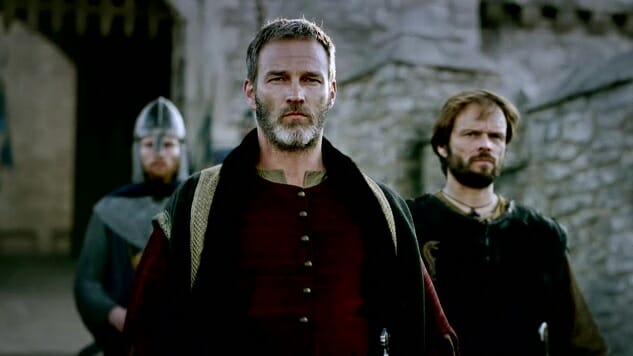
Religion has played at least a subtle role in The Bastard Executioner from the beginning, but “Behold the Lamb/Gweled yr Oen” puts the misdeeds of the church at its forefront. Maybe that can’t be helped: the return of that dastardly archdeacon naturally courts episode-shaping discussions of God and belief, which begin immediately as Toran struggles to come to terms with his actions in last week’s “Thorns/Drain.” But coupled with themes of religion is the theme of deception. “Behold the Lamb/Gweled yr Oen” is deeply interested in the truth and the untruths told by the show’s cast, from Wilkin, to Lowry, to Corbett, and even to the stranger dragged up to Castle Ventris in chains as the story begins in earnest.
This man, Corbett tells Toran and Wilkin and all within proclamation range, is responsible for the murder of Baron Pryce’s wife, and thus has earned himself a punishment most severe. (Sensitive types may wish to avert their gaze at the climax here, though it reminds us yet again of the atrocities people committed during this era, in the name of rightness.) The sequence hangs heavy with Corbett’s fraudulence: As usual, Corbett has a wild card up his sleeve to keep Wilkin in check and in torment at the same time. Wilkin can hardly bring himself to let an innocent man die horribly for a crime he didn’t commit, especially since we all know about Wilkin’s culpability in the matter. So “Behold the Lamb/Gweled yr Oen” weighs his conscience for a good hour or so, in order to test what kind of person he really is.
We don’t really know Wilkin that well as a character, even seven installments into The Bastard Executioner. He’s a vaguely-defined good guy type with a dead wife and a thirst for revenge. That’s about it. In “Behold the Lamb/Gweled yr Oen,” we get to see a little bit more of him, and Lowry does too. All that guilt he’s carried around from telling falsehoods and living the life of another human being has just plain old gotten to be too much for him, and so he spills his guts to Lowry, whose eyes very nearly bulge out of her head in shock. It’s the boldest and possibly most ill-advised gesture Wilkin could make.
Wilkin’s brash confession to Lowry—sort of the medieval version of committing suicide by cop, if you think about it—says a lot more about him than the tried-and-true honor and nobility act he’s put on from the first day he took up the mantle of Gawain Maddox. Frankly, the entire scenario makes him look a good bit more like a hero than he has to date. It also gives Lowry more chance to exercise her power and agency as both the Baroness of Ventrishire and as Wilkin’s quiet ally. Only by her good grace and quick thinking are Wilkin and Toran spared retribution by Corbett. If you needed more reason to trust in her power, well, that ought to do it.
Wilkin’s revelation comes not a moment too soon: he needs to have more to do and more to be than “bitter, heartbroken hunk.” Lowry’s quick acceptance of Wilkin’s truth is moving, though it should come as little surprise that she remains the most interesting character in the series, with Corbett nipping at her heels. “Behold the Lamb/Gweled yr Oen” gives the two of them time to evolve their relationship; they don’t change much as individuals, but rather as a duo, though Corbett does tell us a yarn about his upbringing (just before he caves in Calo’s skull) that makes him damn near sympathetic. Is he a simple demon? Is he a complicated man—a good person who does bad things, or a bad person who does good things?
Killing Calo definitely suggests the last of these, but he kills Calo to fulfill his threat to Wilkin, though the murder is done on the basis of bad information. Corbett, in other words, doesn’t behave randomly, or erratically, or inflict suffering out of wanton indulgence. Everything he does is all according to his best-laid plans and schemes. That doesn’t make him moral or good, of course, but “Behold the Lamb/Gweled yr Oen” suggests that he’s bent toward the goal of making Ventrishire stronger, and everything he does aids in that outcome, whether he’s manipulating Wilkin or pimping out Lowry to Baron Pryce. He’s a dishonestly honest man, a fabulously realized villain, and, perhaps more so than the archdeacon, a focal point of The Bastard Executioner’s religious critique, the ultimate liar who lies in the name of what he believes to be right.
“Behold the Lamb/Gweled yr Oen” is one of the show’s best outings by far. Slick action, harsh violence, and lovely staging provide real entertainment value, while the writing (which feels sharper than before) delves into The Bastard Executioner’s central notion of duality and bringing its exploration of identity full circle. Secrets are losing their meaning here, and at breathtaking speed: the characters are all running out of ways to hide, both literally and figuratively, which should make Kurt Sutter’s history lesson all the more compelling, as his narrative continues to build its inertia.
Boston-based critic Andy Crump has been writing online about film since 2009, and has been scribbling for Paste Magazine since 2013. He also contributes to Screen Rant, Movie Mezzanine, and Birth.Movies.Death. You can follow him on Twitter. He is composed of roughly 65% craft brews.